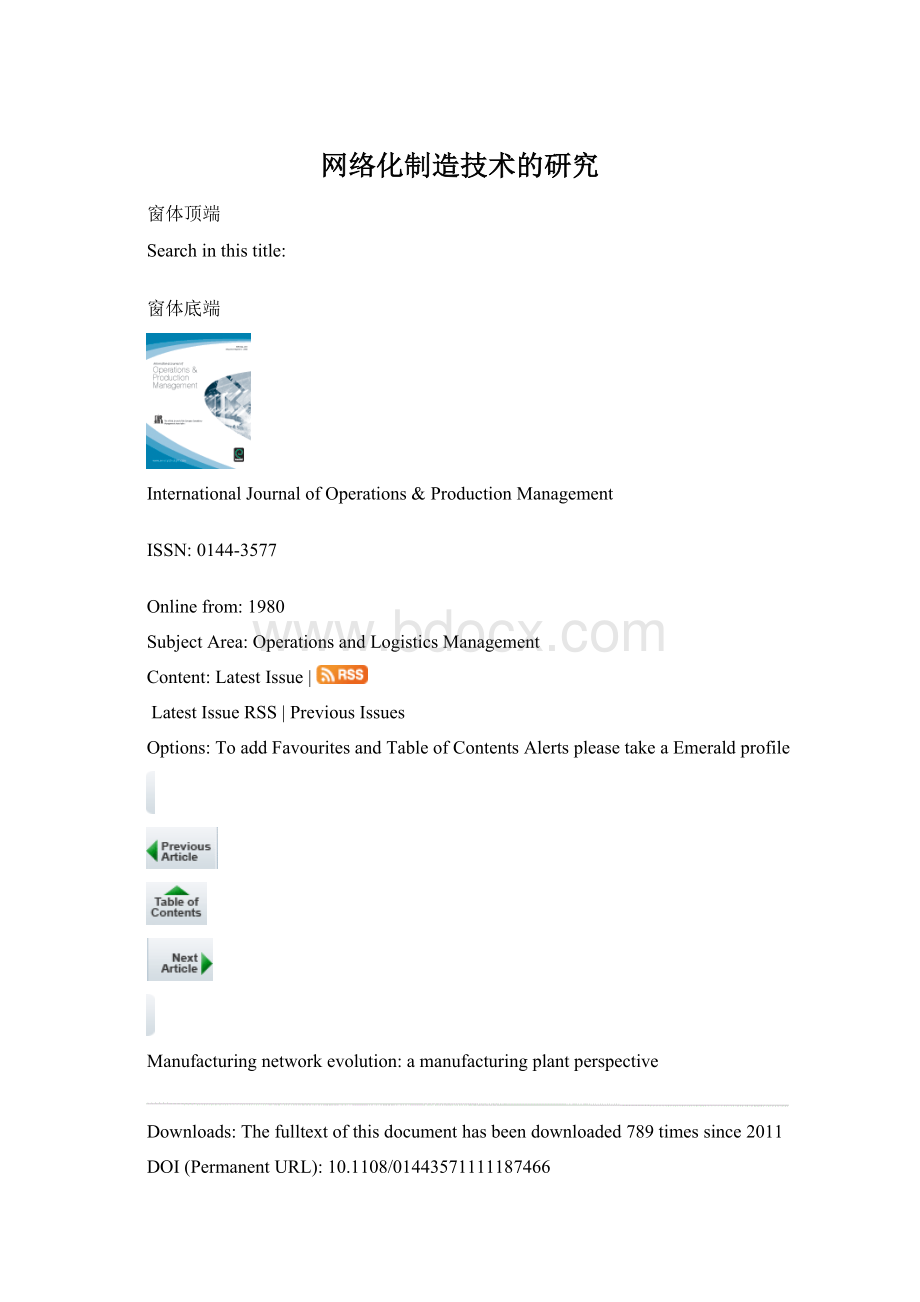网络化制造技术的研究.docx
《网络化制造技术的研究.docx》由会员分享,可在线阅读,更多相关《网络化制造技术的研究.docx(24页珍藏版)》请在冰豆网上搜索。

网络化制造技术的研究
窗体顶端
Searchinthistitle:
窗体底端
InternationalJournalofOperations&ProductionManagement
ISSN:
0144-3577
Onlinefrom:
1980
SubjectArea:
OperationsandLogisticsManagement
Content:
LatestIssue|
LatestIssueRSS|PreviousIssues
Options:
ToaddFavouritesandTableofContentsAlertspleasetakeaEmeraldprofile
Manufacturingnetworkevolution:
amanufacturingplantperspective
Downloads:
Thefulltextofthisdocumenthasbeendownloaded789timessince2011
DOI(PermanentURL):
10.1108/01443571111187466
Articlecitation:
YangCheng,SamiFarooq,JohnJohansen,(2011)"Manufacturingnetworkevolution:
amanufacturingplantperspective",InternationalJournalofOperations&ProductionManagement,Vol.31Iss:
12,pp.1311-1331
Options
Abstract
ViewPDF(136kb)
PrintView
References
∙References(52)
Citations
∙Scopus
(1)
Furtherreading
∙RelatedContent
Searchourarticlesforsimilarcontent
∙Keyreadings
Searchourreviewsforrelateditems
Markedlist
窗体顶端
Addtomarkedlist:
窗体底端
Bookmark&share
Reprints&permissions
Request
TheAuthors
YangCheng,CenterforIndustrialProduction,AalborgUniversity,Aalborg,Denmark
SamiFarooq,CenterforIndustrialProduction,AalborgUniversity,Aalborg,Denmark
JohnJohansen,CenterforIndustrialProduction,AalborgUniversity,Aalborg,Denmark
Acknowledgements
TheauthorswouldliketothankProfessorHarryBoerofAalborgUniversity,Denmark,forhiscommentsonandsuggestionsforimprovingapreviousversionofthisarticle.
Abstract
Purpose–Thepurposeofthispaperistoexaminetheeffectofchangesatthemanufacturingplantlevelonotherplantsinthemanufacturingnetworkandalsoinvestigatetheroleofmanufacturingplantsontheevolutionofamanufacturingnetwork.
Design/methodology/approach–Theresearchquestionsaredevelopedbyidentifyingthegapsinthereviewedliterature.ThepaperisbasedonthreecasestudiesundertakeninDanishmanufacturingcompaniestoexploreindetailtheirmanufacturingplantsandnetworks.Thecasesprovideasoundbasisfordevelopingtheresearchquestionsandexplainingtheinteractionbetweendifferentmanufacturingplantsinthenetworkandtheirimpactonnetworktransformation.
Findings–Thepaperhighlightsthedominantroleofmanufacturingplantsinthecontinuouslychangingshapeofamanufacturingnetwork.Thepaperdemonstratesthataproductorprocesschangeatonemanufacturingplantaffectstheotherplantsinthesamenetworkbyalteringtheirstrategicroles,whichleadstothesubsequenttransformationofthemanufacturingnetwork.
Originality/value–Areviewoftheexistingliteratureinvestigateddifferentelementsofamanufacturingnetworkindependently.Inthispaper,thecomplexphenomenonofamanufacturingnetworkevolutionisobservedbycombiningtheanalysisofamanufacturingplantandnetworklevel.Thehistoricaltrajectoriesofmanufacturingnetworksthatarepresentedinthecasestudiesareexaminedinordertounderstandanddeterminethefutureshapeofthenetworks.Thisstudywillhelpindustrialmanagersmakemoreknowledgeabledecisionsregardingmanufacturingnetworkmanagement.
ArticleType:
Researchpaper
Keyword(s):
Denmark;Manufacturingindustries;Operationsmanagement;Manufacturingnetwork;Manufacturingplant;Globaloperationsmanagement.
Journal:
InternationalJournalofOperations&ProductionManagement
Volume:
31
Number:
12
Year:
2011
pp:
1311-1331
Copyright©
EmeraldGroupPublishingLimited
ISSN:
0144-3577
1Introduction
Sincethelate1980s,manufacturinghasbecomemoreinternationalbecauseitisthesinglelargesttypeofforeigndirectinvestmentinmostcountries(Yip,1989;Kogut,1990;Ferdows,1997a).Infact,astradebarriersfell,transportationbecameeasier,andcommunicationtechnologiesimproved,manufacturersbenefitedfromtheadvantagesofchoosingglobalisation(Ferdows,1997a;GhoshalandBartlett,1990).Therefore,duringthelast20years,multinationalcorporationshaveattemptedtoglobalisetheirgeographicallydispersedplantsbycoordinatingthemwithasynergeticnetwork(Ferdows,1997a,b;ShiandGregory,1998).Thisintegrationhasresultedinarapidchangeinmanufacturingsystemconcepts,whichhavemovedfromafocusontheplantfocustooneoninternationalmanufacturingnetworks(Ferdows,1989;RudbergandOlhager,2003).Accordingly,thisshifthashadaconsiderableimpactonacompany'sfutureperformanceandprofitability.Thus,managinganintegratedinternationalnetworkhasbecomeanincreasinglyimportanttaskformanufacturingcompanies(BartlettandGhoshal,1989;Hayter,1997).
Nevertheless,intheexpansionfromanindividualplanttoaninternationalmanufacturingnetwork,manyconstructsneedtobetakenintoconsideration,whichmakesanalysingandmanagingthenetworkacomplextask.Therefore,itisessentialtounderstandboththenetworktransformationandtherelationalinteractionsamongthedifferentnetworkconstructs.Inmostcases,theglobalpositioningofmanufacturingorganisationsintermsofestablishinganewfacility,relocatingorclosingaproductionfacilityhasresultedinanextendednetworkorformulationofanewnetworkthathasleftbehindafootprintthatcanbeevaluated.Thishistoricaltraceprovidesanopportunitytodevelopabetterunderstandingoftheevolutionanddevelopmentofamanufacturingnetworkanditsconstituentnetworkconstructs.Thefuturedecision-makingcapacityofamanufacturingcompanycanbegreatlyimprovedbylearninghistoricallessonsfromthewell-tracedfootprintofaconstantlyevolvingmanufacturingnetwork.
Accordingtovariousresearchers,amanufacturingnetworkisanaggregationofplantslocatedindifferentplaces(Ferdows,1989;RudbergandOlhager,2003).Thus,theplantmaybeviewedasthebasicconstructinamanufacturingnetwork.Inthispaper,wefocusonplantsinthecontextofthemanufacturingnetworkandattempttounderstandtheinteractiverelationshipbetweentheevolutionsofplantsandtheentirenetwork.Weconsideraplanttobetheintegralpartofamanufacturingnetworkandassumethatwheneverpartofanetworkchanges,itisunlikelytohappeninisolation;instead,ithasimplicationsfortheentirenetwork.
Thispaperisstructuredasfollows.Theliteraturereviewfirstinvestigatesexistingstudiesthathaveexaminedrelationshipsbetweenplantsandmanufacturingnetworksandthenhighlightsthegapintheoryandpractice.Withtheaimofbridgingthisgap,theresearchquestionisthenformulated.Aftersomemethodologicalconsiderations,industrialcasesofthreeDanishmanufacturingcompaniesarepresented.Thesethreecasesillustratetheevolutionofmanufacturingplantsandglobalmanufacturingnetworksfromahistoricalperspectiveandareanalysedindetail.Theessentialnatureoftheinteractiverelationshipbetweentheevolutionofamanufacturingnetworkanditsplantsisdescribedandfurtherelaboratedbyaprocessmap.Weconcludethispaperwithsuggestionsforthemanagementofmanufacturingnetworksandpossibledirectionsoffutureresearch.
2Literaturereview
2.1Literatureonthemanufacturingplantlevel
Duringthelate1970sandtheearly1980s,morescholarsnoticedtheneedtomanagenotonlythesingleplantbutalsomulti-plantorganisations.However,researchduringthisperiodwasmainlyconcernedwithlocationdecisions(ShiandGregory,1998;MeijboomandVoordijk,2003).Eachplantwastreatedasaseparatesinglefacilityandnetworkingissueswereignored(Schmenner,1982).Atthattime,plantlocationdecisionmakingreferredmerelytotheselectionofasiteforanewplant.Forsomeplants,thechoicewasstraightforward,involvingonlytheselectionoftheleastcostlysite(Schmenner,1979).However,morerecentresearcharguedthatcostevaluationdoesnotrevealthecompletestory.Furthermore,itsometimesdoesnotshowdifferencesthataresignificantenoughtomakealocationchoicestrictlyonitsmerit.Researchersandmanagersshouldthereforelookbeyondtheobviousinplantlocation.
Becauseplantsareexpectedtocontributemorethanlowercoststocompanies,theyarerecognisedasbeingcapableofplayingdifferentrolesinmanufacturingnetworks(Ferdows,1989,1997b).AlthoughtheconceptofplantroleswasfirstintroducedbyFerdows(1989,1997b),discussionsonplantrolesgenerallybeganwiththerolesofsubsidiariesinmultinationals.Theliteratureoninternationalstrategyprovidesseveraltaxonomiesdescribingthestrategicrolesofthesesubsidiaries(BartlettandGhoshal,1989;RothandMorrison,1992;GhoshalandNohria,1993;Taggart,1998),givingrichinsightsintothedistinctstrategicrolessubsidiariesmayplayinmultinationals.Ferdows(1989,1997b)translatedthestrategicclassificationsofsubsidiariesintothemanufacturingclassificationofplants.Hismodeldistinguishesplantsonthebasisofplantcompetencesandlocationadvantages,andidentifiessixtypesofplants,whichhelabelsoffshore,source,server,contributor,outpost,andleadplant.Ferdows'smodelgainedacademicrecognitionandmanyresearchershavetakenitasapointofdeparturefortheirresearch(VereeckeandVanDierdonck,2002;FuscoandSpring,2003;MeijboomandVoordijk,2003;MeijboomandVos,2004;Maritanetal.,2004).Forexample,VereeckeandVanDierdonck(2002)discussedandtestedthismodel.Theirdatashowedthattheroleofthecentreofexcellenceinamanufacturingnetworkisnotrestrictedtoplantswithknow-howastheprimarylocationadvantage,butisacommonroleofplantswithmarketproximityastheprimaryadvantage.Theyalsoprovedthatthemodelisuseful